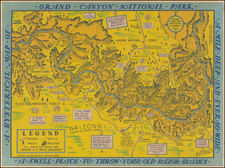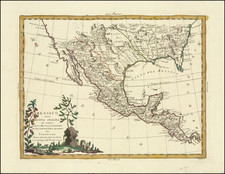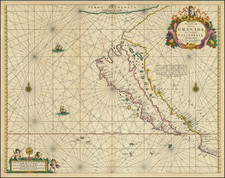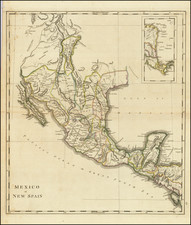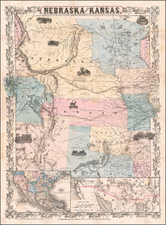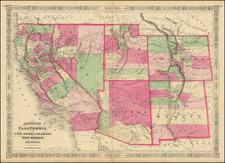Highly important and skillfully executed large format manuscript map showing the area around Georgetown, Colorado Territory, at the beginning of the Colorado Silver boom and the birth of Georgetown.
The map offers a remarkable early graphical depiction of Georgetown's earliest days following the discovery of silver in the region. Discovered in 2007 in Burlington, Vermont, the map ties together a fascinating period of Georgetown's pre-history with its earliest documented history, for which there are no surviving maps or illustrations. After preliminary research, we surmise that the present map was prepared by or with the assistance of Charles Hoyt and sent back to Burlington, Vermont in the Summer or early Fall of 1867, as a means of raising capital to continue the work originally capitalized by the so-called "Green Mountain Silver Mining Company." However, for reasons unknown, the incorporators of the Green Mountain Silver Mining Company were unable to raise the capital required, leading to the formation of the Burlington Silver Mining Company in November 1867. With the new capital secured, the promoters (most likely Arthur Hoyt) returned to Georgetown and commenced work developing their claims, including the successful development of the New Boston Lode, one of the earliest producing loads in the region.
Silver was first discovered in the Georgetown area in 1864. As noted by Fossett, "In the fall of 1864, Gov. Steele, J. Hough and Mr. Pine, having some faith in the existence of silver . . . left Empire, and after camping at Georgetown started up the south fork of the creek [where they discovered the first silver]." Gov. Steele was undoubtly Robert Williamson Steele, Governor of the locally formed Jefferson Territory, which preceded Colorado Territory. Steele served as Governor of Jefferson Territory from November 1859 to June 1861. The U.S. Congress created Colorado Territory in February 1861 and the new Gov. William Gilpin arrived in Denver in early June. When Gilpin, arrived, Steele issued a proclamation dated June 6, 1861 disbanding Jefferson Territory and thus abolishing his own Governorship.
The first prospectors began coming to the area around Georgetown in 1865 (including Caleb Stowell, whose name appears on the map). Fossett notes that in the fall of 1865, M. P. Parker and John Cree had located the Henry Ward Beecher, New Boston, and other veins, on Democrat mountain above Georgetown. These veins are two of the veins which appear on the present map below Silver Mountain, which is clearly the Democrat Mountain referenced by Fossett. The New Boston vein would apparently go on to be one of the major veins in the area and apparently the major asset of the Green Mountain Silver Mining Company and later the Burlington Silver Mining Company.
The Green Mountain Silver Mining Company was incorporated in 1865 in Vermont, making it one of the earliest companies formed to exploit Silver Mining Claims in Colorado. We have not been able to locate any evidence that the company was active in the Georgetown area and it is more likely that in 1867, the claims were transferrered to the Burlington Silver Mining Company, which was incorporated in Vermont in late 1867 by a number of prominent Burlington businessmen, including Horatio G. Loomis (pioneer Chicago settler and businessman and one of the founders of the Chicago Board of Trade in 1848, retired to Burlington by 1882), Arthur W. Hoyt, Joseph Clark (Trustee, Vermont Central RR), Jedidiah P. Clark (prominent Burlington Grocer), Charles F. Ward (co-Founder of Burlington Savings Bank) and Obidiah J. Walker (Burlington Merchant). Loomis, Hoyt and Sayles Nichols (son of Horace Loomis?), were also the holders of the claim to the "New Boston Lode" at the time the New Boston Lode was surveyed by the US Surveyor General's Office on July 23, 1869 (Survey No 46, Mineral District 2--by F F Brune, US Deputy Surveyor). Other claim holders as of the date of Survey No. 46 included Frederick van Sicklen (Howard National Bank of Burlington) and George P. Woods, with no mention of the other incorporators.
According to Bancroft (p 591), "In 1867, [Georgetown and neighboring Elizabeth Town] was re-surveyed and platted by Charles Hoyt, under the direction of the citizens, and the name changed to Georgetown [merging the two settlements], by vote at a mass meeting held at the corner of Rose and Mary Streets. At the general election of this year, [Georgetown] became the county seat, and was incorporated in January 1868." The precise detail of the present map, which includes a plat of the two settlements as a single united Georgetown, strongly suggests that this map was either prepared by Charles Hoyt or prepared with an intimate knowledge of his survey and map. Our best guess is that this map was prepared sometime between June 1 and September 1, 1867, so it is possible that it was completed even before Hoyt's plat was completed. Given the size of the town at the time, it is also unlikely that there were other skilled map makers in residence. While we have not been able to link the two men, it is probable that Charles Hoyt was a relative of Arthur W. Hoyt one of the incorporators of the Burlington Silver Mining Company.
The map is oriented with west at the top and tracks the Argentine Road past Leavenworth Mountain from the south, along a branch of Clear Creek into the original site of Georgetown, where a second branch of the Clear Creek covers the area from the west. The map locates Watson's Furnace, Johnson's Furnace, Stowell's Furnace and the Reducing Works of "G. Martin & Co" (Garrett Martine & Company) on the south side of the town, along with Cassidy's Scotch Hearth and Washington's Furnace on the north end of the town. Several other unnamed buildings are located.
Hollister writes that 3 of the furnaces shown on the map were constructed in 1866 (most likely Washington Furnace, Stowell's Furnace, Watson's Furnace). "Johnson's Furnace" was likely built in 1865 and was probably the furnace of the "Georgetown Silver Smelting Company," which Hollister described as "sheltered on the west by a mountain wall a quarter of a mile high, lying along and including the right fork [of the creek] for several hundred feet.... There are two frame buildings on the ground ....". Hollister further notes that Mr. Johnson is "the agent of the Company" . In describing the Georgetown Silver Smelting Company property, Hollister states "The creek has been dammed and a flume made, giving about thirty feet fall". That "flume" is a water channel - carved out in the ground and often encased in wood to form a sort of tunnel - to provide water to the smelting works. This channel and flume appear on the present map.
The location of the Garrett Martine & Company reducing works in 1867 is also of great significance. According to Hollister, the company first commenced silver smelting operations around June 1, 1867 and would go on to manufacture the first silver brick in the State of Colorado later the same year (Bancroft, p. 587).
The map also locates the "New Road to Snake River." The road, which would come to be known as the Watson Wagon Road (present route of I-70 from Georgetown to the Eisenhower Tunnell), was constructed by Joseph W. Watson (owner of Watson's Furnace), at a cost of $15,000 (see Hollister). The Watson Wagon Road was illustrated later in September 1867 by a massive manuscript panoramic view of the Watson Wagon Road by Morse & Hill, Civil & Mining Engineers, Central City, Colorado, now in the collection of the Denver Public Library and prominently displayed on the wall of the 5th Floor Western History Reading Room. A comparision of the two suggests that this map pre-dates the Morse & Hill view.
Stowell's Furnace would likely have been a part of the mill erected by Caleb S. Stowell near Geogetown in 1866, wich included a blast furnace. The furnace was initially not successful in creating the necessary heat to smelt the ore, until an African American by the name of Lorenzo M. Bowman, who had set up his own furnace nearby and had previously worked in the lead mines in Missouri, was able to supply the necessary practical knowledge to melt the ore and create pure silver.
The present map is a remarkable snapshot of early Georgetown history, providing a graphic depiction of one of Colorado's most important boom towns on the eve of its explosive development.









